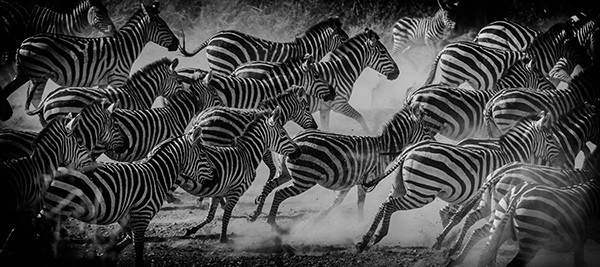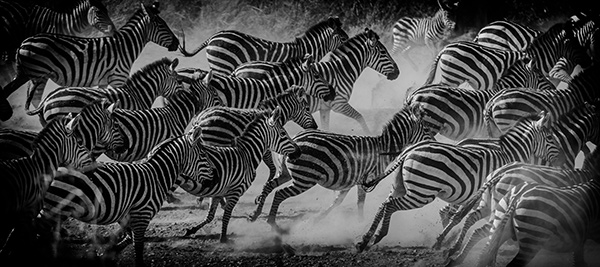Share
Selling Fine Art Photography Tip #4: Peter Carroll on Striving for the Best Quality Print
This is the fourth blog post in a series from our newest guide Selling Fine Art Photography. Download it here. In October 2010, Peter Carroll witne...

This is the fourth blog post in a series from our newest guide Selling Fine Art Photography. Download it here.
In October 2010, Peter Carroll witnessed a unique event at one of Australia’s most prized natural wonders: Uluru, a sacred rock formation in central Desert Country. It was one of those rare times of torrential rainfall, causing short-lived streams to run down the red rock and create dramatic color changes—all of which were captured on film by Peter. He sent one of the images to an Australian newspaper, and soon after the image was being showcased by major magazines and radio stations in both Australia and overseas.
Before the Uluru photo, Peter was introduced to photography in the late 1980s by the owner of International Park Tours, where he worked as an eco-adventure tour guide. It was a natural progression to want to capture the landscapes he spent so much time exploring. A camera was ever present, but never seen as a way to earn a living. On returning to Australia in 2005, he felt his photography was at a level to take it on seriously, and began to sell prints and cards at local art outlets and markets. Then, there was Uluru: “It began my career at least a year earlier than I would have looked [to start it] otherwise. I’m not complaining—it was the biggest kick in the pants and necessary in some ways.”
Everything since then has been a massive learning curve for Peter. He talks about not really knowing how to sell his work, and after the Uluru images were taken on by several major publications, he got what he calls a “hard message” from a photographer friend: “He told me what I was doing wrong—that I was basically giving [the images] away, and I wasn’t doing photography any favors.”
Since then, Peter has been on a journey to learn more about the business side of photography. “I never wanted to be in business—it never interested me. But this journey has blossomed into learning about business and I’ve found out that it’s fascinating,” he says. “I’m not kidding that PhotoShelter has probably been the most important factor in learning about what can be done [for your photography]. It’s a lot easier to learn when there’s an active crew behind the product and feeding you information.” One of Peter’s takeaways has been to utilize Google Analytics to monitor his website’s traffic and see where his visitors come from. When Uluru first came out, he saw massive spikes in his traffic, but as Peter says, “when the hoopla finishes, it drops right back down. I’ve really learned that it’s important just to get traffic to the site, because as the traffic numbers drop, so do the requests for your images.”
With that in mind, Peter has been looking at other sales avenues to sell not only more editions of the Uluru images, but his other landscape photography as well. He sees a market for his work in hotels and resorts, which would want to exhibit the surrounding landscape as art in their guests’ rooms. With the increased exposure, he hopes to drive more traffic to his site where potential customers could buy prints.
But before anything sells, Peter must be totally satisfied with the quality of the print. “It’s important to produce the best quality work that you possibly can, so that you can stand 100% behind that work and people can know how much you’ve gone through to get the print to that point,” he says. In fact, Peter came to realize that quality printing can make or break your fine art photography. “Beautiful paper,” he says, “changed my whole idea of presentation. Part of fine art is making the best quality print from the file, and there is a lot of work that takes place.” Today, Peter works with Master Printer Warren Macris of Giclee, Australia who’s helped him nail down the best printing process for his images.
“For me, the physical print is everything. It must be museum grade archival quality, and Macris has the experience and passion to print your vision without compromise.” Peter prints most of his work on Canson rag Photographique 310gms, but he also looks to experiment with other high end art papers, depending on the image or series.
For Peter, fine art is also about the time that he spends in the environment and what he goes through to get the shot. “It’s all about waiting for the right time and light, traveling to the right destination and learning about the subtleties of how the weather affects the scape and how you want to capture it.” His method is not to take hundreds of shots, but a handful that really capture the feelings that he had while viewing the landscape. “With fine art landscapes,” he says, “I’ve realized that you really have to have the ‘hero photo’ and then have a series of 10 or 12 images that capture and sum up the experience.”
Another piece of advice that Peter has for photographers in general is to refrain from posting your images to Facebook and Twitter right away. “You want to show them off and you’ve got so much emotion flying through you, but it’s important not to give away too much. Sit on them until they’re ready.” Another piece of advice from Peter, specifically when reaching out to galleries, is to find out how each gallerist wants to be approached by photographers, since everyone has different preferences. Peter has found success in bringing physical books of high-quality prints to the gallery so that people can look through his work, which he says has gone over well with the gallerists that he’s visited.
Peter knows the value of self-promotion, but he’ll be the first to tell you that he still considers himself a family man and father first, and a professional photographer second. Most recently, Peter has been traveling extensively, spending almost all of 2013 in Southern and East Africa and was named one of National Geographic Travelers of the Year 2013. He’s also now in the process of producing a specific series out of all his images from this past year.
For more tips from fine art pros, download the Selling Fine Art Photography today!







